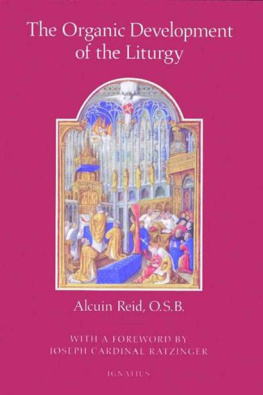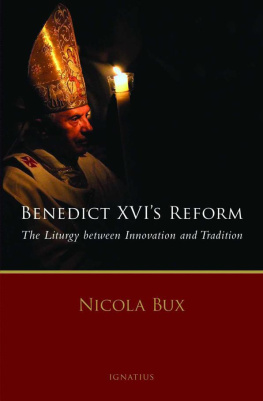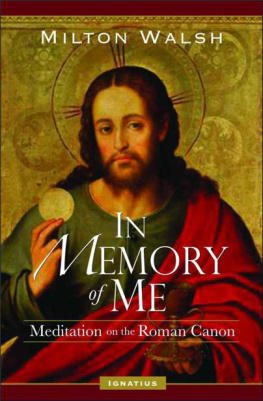CEREMONIES OF THE MODERN ROMAN RITE
PETER J. ELLIOTT
Ceremonies of the Modern Roman Rite
The Eucharist and
The Liturgy of the Hours
~
A Manual for Clergy and All Involved in Liturgical Ministries
Revised Edition
IGNATIUS PRESS SAN FRANCISCO
Nihil Obstat: Rev. Gerard Diamond, M.A. (Oxon), L.S.S., D. Theol. Diocesan Censor
Imprimatur: Msgr. Les Tomlinson, Vicar General Archdiocese of Melbourne
September 3, 2004
The Nihil Obstat and Imprimatur are official declarations that a book or pamphlet is free of doctrinal or moral error. No implication is contained therein that those who have granted the Nihil Obstat and Imprimatur agree with the contents, opinions or statements expressed. They do not necessarily signify that the work is approved as a basic text for catechetical instruction.
Cover design by Roxanne Mei Lum
First edition 1995 by Ignatius Press
Second revised edition 2005 by Ignatius Press
ISBN 978-0-89870-830-1
Library of Congress Control Number 2004112734
Pro fratribus
Contents
The Baptistery
The Nave
The Sanctuary
The Altar
The Tabernacle
The Sacristy
Other Liturgical Areas
The Love of the House of the Lord
Sacred Vessels
Sacred Objects
The Linen
The Vestments
Liturgical Colors
Choir Dress
The Vestments of the Bishop
The Matter of the Sacraments
The People
The Choir
The Sacristan
The Servers
The Master of Ceremonies
The Lector
The Acolyte
The Deacon
The Priest
The Bishop
The Hands
The Sign of the Cross
Blessings
Genuflections
Bows
Prostrations
The Liturgical Kiss
The Voice
The Eyes
Memorization
Incensations
Holy Water
Decorum and Experience
Preparations
Entrance Procession
Introductory Rites
Liturgy of the Word
Liturgy of the Eucharist
Communion Rite
Concluding Rite
Rite of Blessing and Sprinkling Holy Water Collections and Stipends
Preparations
Entrance Procession
Introductory Rites
Liturgy of the Word
Liturgy of the Eucharist
Communion Rite
Concluding Rite
Preparations
Introductory Rites
Liturgy of the Word
Liturgy of the Eucharist
Communion Rite
Concluding Rite
A Concelebrated Mass of Christian Burial.
Solemn Pontifical Mass
A Median Form of the Bishops Mass
A Simple Form of the Bishops Mass
The Bishop Presides at the Liturgy of the Word at Mass
Bishops Present at Mass in Choir Dress
Mass at Which Only One Minister Assists
Ritual Masses: Celebrating a Sacrament during Mass
Mass outside a Sacred Place
Celebrating Mass with Children
The Mass of Thanksgiving of a Newly Ordained Priest
Blessing a Chalice and Paten during Mass
Ministering the Eucharist
Communion of the Sick
Viaticum
Holy Communion outside of Mass
A Sunday Celebration in the Absence of a Priest
Solemn Adoration of the Holy Eucharist
The Simpler Form of Adoration
Exposition at the End of Mass
A Eucharistic ProcessionCorpus Christi
Other Forms of Adoration
Solemn Vespers
Vespers and Eucharistic Adoration
The Bishop Presides at Vespers
A Simpler Form of Vespers
The Other Hours
Mass Combined with an Hour
Foreword
I have the honor to present this new book of Msgr. Peter Elliott, a faithful collaborator and expert in our Dicastery. Msgr. Elliott has solid experience, not only theoretical but also pastoral, as is evident in this work which was written with love for the Church and priestly commitment. In fact the liturgical action is the heart of the ministerial priesthood: The ordained minister is, as it were, an icon of Christ the priest. Since it is in the Eucharist that the sacrament of the Church is made fully visible, it is in his presiding at the Eucharist that the bishops ministry is most evident, as well as, in communion with him, the ministry of priests and deacons ( Catechism of the Catholic Church , 1142).
Reading through Ceremonies of the Modern Roman Rite , I recalled various moments in my own experience, in the Conference of the Bishops of Latin America (CELAM), both as Secretary and President, and also as Archbishop of Medellin, Colombia. I recalled especially how, among faithful ministers, there is a great desire and willingness to deepen the understanding of the Liturgy and so enjoy its rich spiritual and pastoral fruits. Both in the life of the particular Church and through the global experience of Rome, one gains a sense of how worship can be carried out worthily, with noble simplicity and active participation. This was the vision and ideal of the Second Vatican Council.
However, I have long been concerned that we still face problems in the way the Sacred Liturgy of the Roman Rite is celebrated. The riches of the Liturgy as renewed in the light of the Second Vatican Council are not always fully drawn upon. In some places one encounters disorder or innovations, based on ignorance of, or disregard for, the norms of Catholic worship. At times, one also notes a lack of a sense of prayer and reverence during the celebrations of the Eucharist.
Therefore I warmly welcome this practical manual, which is the fruit of the scholarly and pastoral interest of Msgr. Elliott. He is offering a service to the clergy and all involved in liturgical ministries, fully in accord with the needs of the post-conciliar Church. This may well be the first extensive ceremonial manual published since the Second Vatican Council. But the reader will find that this book has a broader scope and a more encouraging tone than some old manuals. Attention to detail, so important in preparing liturgical celebrations, is balanced by sensitivity to pastoral needs. One also finds a strong doctrinal and spiritual theme running through the entire work, inviting the reader to understand the beauty of ordered ceremonial within Christian life and so to reach out and strive for something better.
One could say that the ceremonies of the Church are described here in a classical way. Msgr. Elliott respects both the traditions and the renewal of the liturgy. He is faithful to the authorities and official sources, and he offers ready access to information not easily gained. Therefore, his interpretation of doubtful points is reasoned, clearly explained and at times challenging.
In serving our Dicastery, Msgr. Elliott has also acquired a broad pastoral vision through his direct contacts with various nations and cultures. The reader will gradually become aware of this in studying his reflections on the Liturgy.
I hope that such an eminently practical book will be a great help to all involved in liturgical ministries. I also look forward to seeing it appear in other languages so that the wider family of the Church may benefit from its ample and rich content.
Alfonso Cardinal Lpez Trujillo
President of the Pontifical Council for the Family
Preface to the Revised Edition
Since Ceremonies of the Modern Roman Rite first appeared in 1995, it has spread widely throughout the English speaking world, and has been translated into Spanish as the Guia pratica de liturgia (Pamplona: Ediciones Universidad de Navarra, 1996). The need for this revised edition emerged in light of the publication in 2002 of the third Latin typical edition of the Roman Missal , together with a revised General Instruction of the Roman Missal . Specific changes derived from these sources have been incorporated into this new edition. A further authoritative source is also cited, the Instruction of the Congregation for Divine Worship and the Discipline of the Sacraments, Redemptionis Sacramentum, on certain matters to be observed or to be avoided regarding the Most Holy Eucharist , 2004.
Next page



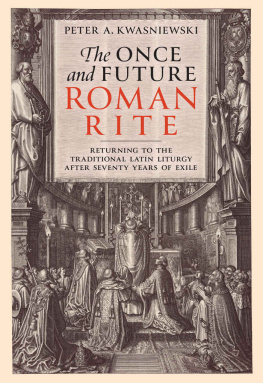
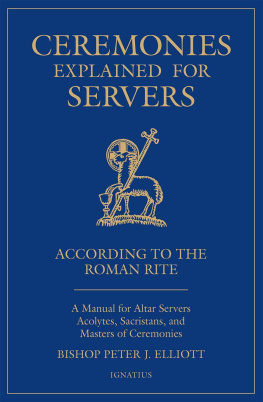
![Pope John XXIII - The Roman Missal [1962]](/uploads/posts/book/272720/thumbs/pope-john-xxiii-the-roman-missal-1962.jpg)
